Splatoon Review
Splatoon
Update: All our original quibbles still remain
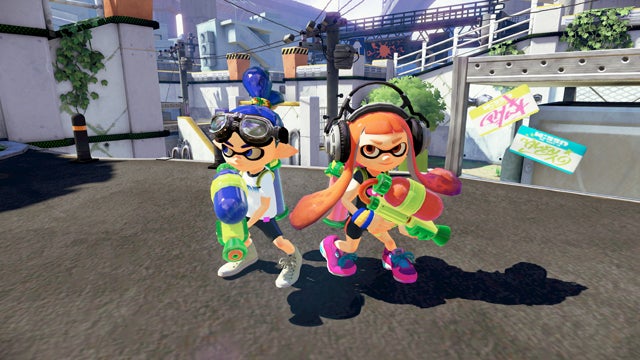
Verdict
Pros
- Ingenious game mechanics
- Vibrant graphics
- Inventive single-player campaign
- Accessible yet deep
Cons
- Lacks variety
- Can feel grindy in the early stages
Key Specifications
- Review Price: £38.95
READ ALL ABOUT: Splatoon 2
Exclusive to Wii U
Every online shooter has its honeymoon period, but it usually isn’t long before the cracks start showing. In some these cracks are tiny and papered over by patches soon after release. In others, they’re gaping flaws that need more radical improvements to address. While not a conventional online shooter, Splatoon is no exception.
On the good news front, playing on live servers is a lot more enjoyable than playing the pre-release code. Waits for games are very short indeed, while the netcode seems pretty stable. We’ve had odd games crash here and there, but nothing more, and in at least one case we suspect a rage quit. The Inkopolis hub has also become a more lively, vibrant place. It’s always been a more interesting way to buy weapons and gear than boring old menus, but now it feels like a meeting place for the Splatoon community.
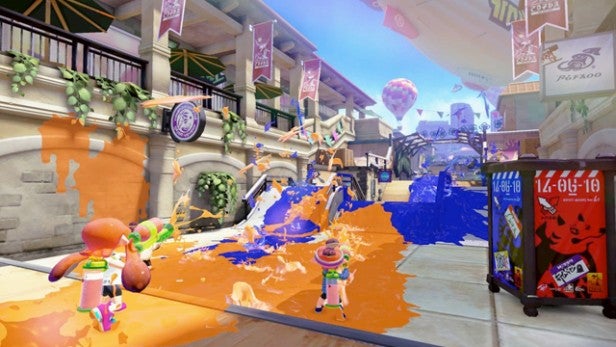
On the bad news front, having to work your way up to level 10 and above isn’t any less grindy than it was in the pre-release version, and the way the matchmaking system often sets you up with more experienced, better-equipped players can be infuriating. When a squad of sub-level 5 players is matched against one with level 13, 14, and 15 players, bearing primo kit, you have to wonder what’s going on.
Nor have our concerns about weapon balance evaporated. It’s not that inklings armed with the Krak-On Splat Roller are unbeatable, but it sure takes a whole lot of work, and the amount of ink one can slap down and the speed with which the special weapons are unlocked makes them the biggest threat in many matches, followed rapidly by high fire-rate Aerospray MG and Aerospray RG. Only Nintendo has the data to prove or disprove our suspicions, but anecdotal evidence suggests that the team with the most Krak-On Splat Rollers usually wins, unless – as sadly sometimes happens – all four players come packing them. This leaves the team too vulnerable at range.
See also: Best Wii U Games
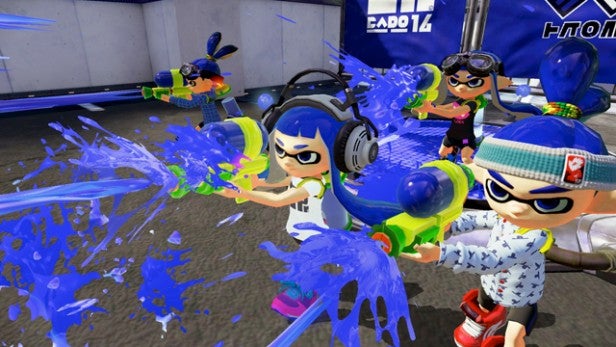
Effective tactics are emerging. While we’ve struggled with the charger weapons, we’ve seen some players making brutal use of them from high positions, while sneaky assassins popping up from squid form with a headshot are a growing menace. Unfortunately, while this strategy nets you an impressive kill/death ratio, it doesn’t usually get a lot of ink on surfaces or win you games. That’s fine if you’re working with a crack team of Krak-On specialist, but not so much if not.
Nintendo has also introduced a whole new weapon class – the brush. In some ways a cross between a roller and a shooter, it has some paint-laying powers and close-combat perks, but it’s no match for the Krak-On for coverage and leaves you weak at any kind of range.
Splatoon’s biggest problem, though, remains repetition. Restricting Battle Mode and Ranked Mode to two maps apiece soon gets dull once you’ve been playing for an hour, and there’s just not enough interest or variety in the maps. People have been calling Splatoon the Mario Kart of shooters, but where Mario Kart shines in its roster of racers and exciting, distinctive, event-filled tracks, Splatoon struggles. Where are the ingenious mechanisms we find in single-player mode? Why is so much of the scenery so generic? Sure, it’s a canvas for big, blobby paint splats, but couldn’t we have a little more imagination? This week’s new map, Port Mackeral, is good, with a large space to splatter and some intense choke points, but is it all that memorable? Nope.
See also: Best Games
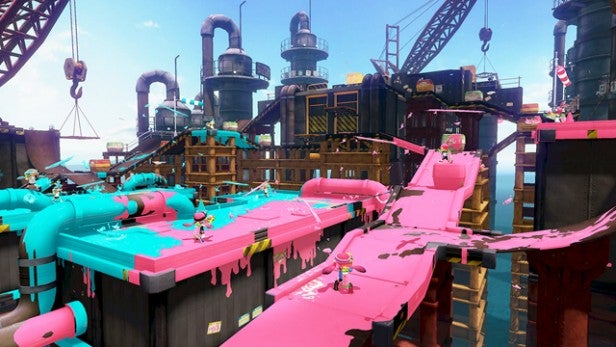
A lack of different game modes doesn’t help either. Ranked Battle’s Splat Zone has a very different feel from the basic Turf Wars. With all attention focussed on painting two marked zones, ranged weapons and specifically Charger weapons grow more useful, while roller weapons lose their dominance. Unfortunately, if anything it’s more repetitive than Turf Wars; a series of firefights staged in two small areas of the map, where the two teams spend half their time scrapping for higher ground.
Which leads us to the biggest issue. Right now, we’re getting bored of Splatoon. We’re not sure we have the interest or the enthusiasm to level up, rank up, get new gear or keep coming back for more. It could be that we’re alone in this, but we suspect that’s not the case. And this is hugely frustrating.
Updated Verdict
Splatoon is a wonderful concept with fantastic core mechanics and Nintendo’s usual genius when it comes to visuals, scene setting and presentation. It’s incredibly close to becoming the Mario Kart of Shooters that some people seem to think it is. Yet without more maps, a less restrictive approach and more inventive game modes, it might not hold our interest for more than a few weeks. With this in mind, we’re downgrading the score to 7 until Splatoon is more fully fleshed-out. More content should be on its way this summer, and we just hope that addresses our concerns.
See also: PS4 vs PS3
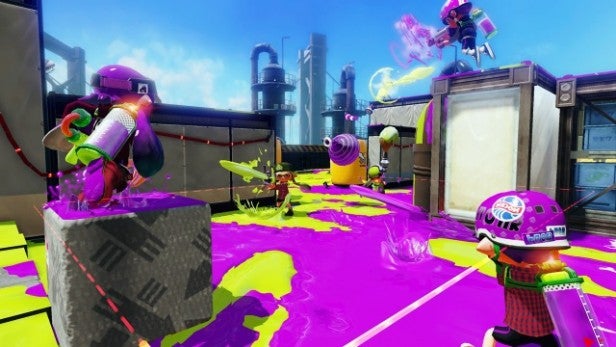
Original review – May 27 2015
“Staaaay Fresh!”, as the Squid Sisters say at the end of every edition of Inkopolis News. It’s a catchy sign-off to a typically Nintendo means of showcasing the day’s maps before play, but staying fresh is one of Splatoon’s biggest challenges. It’s a game that’s fantastic fun in the short-term, but will it still feel as exciting weeks or months down the line?
Nintendo’s reinvention of the online shooter is intelligent, stylish and hardly short on flair. In the arenas of Inkopolis, gangs of weird, teenage human/squid hybrids face off with an array of ink squirting, splatting, rolling weaponry. The team that covers more of the arena in its own coloured ink is the winner. Sure, kills and deaths count towards your individual score, but the really important thing is coverage.
See also: Splatoon tips and tricks
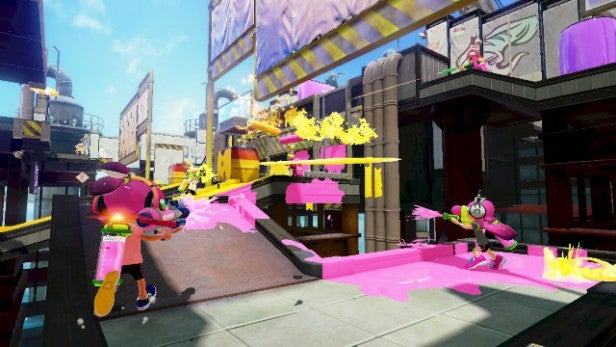
This all makes Splatoon a more, well, fluid game that the majority of online shooters. Standing still and sniping with a charged squirter – the game’s equivalent of a rifle – will get you roughly nowhere unless you’re also using your position to defend your zone and spread some ink. An assault on an enemy position only works if you’re going to splatter brightly coloured fluids on your way.
Ink is the lifeblood of Splatoon in more ways than one. Inklings can transform into squid form and move rapidly through pools and streams of their own coloured ink. While in squid form they’re camouflaged, and they also replenish their spent ink. Meanwhile, enemy ink causes damage, killing you if you stay in contact for too long. When you blaze a trail of ink through enemy territory you’re not just gaining ground but creating a path through which others can follow. When the enemy covers choke points in ink, meanwhile, they’re potentially cutting you off from backup and home.
See also: Best Wii U Games
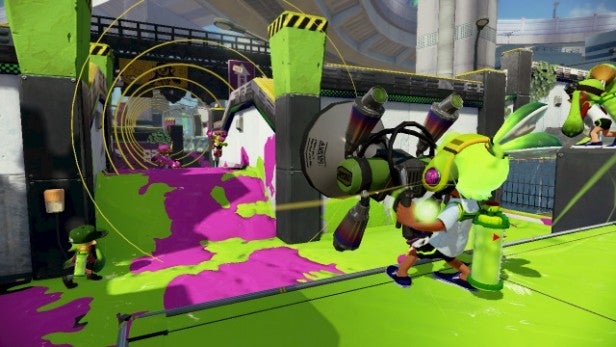
Splatoon is accessible, with simple controls and easily-understood objectives, but there’s a layer of skill and strategy lurking beneath its super-saturated palette. Dominating the territory, making tactical incursions, playing as a team and checking the map on the Wii U GamePad are all crucial to getting regular wins, as will getting to grips with the more advanced controls and movement options. Using motion controls for precision aiming takes getting used to, but once you do it’s a definite plus.
At first your weapons are fairly basic – a simple rapid-fire squirter and an ink grenade. Playing well wins you experience points and cash, unlocking new tiers of weapons, plus clothes, shoes and hats with a variety of perks, some useful straight away, others unlocked by playing with the item equipped. All this stuff can be purchased in the stores of Splatoon’s Inkopolis hub with your hard-earned cash. To make things more complex, each weapon comes as part of a set with a different secondary weapon – a new grenade, sticky-bomb, heavy weapon or ink sprayer – plus a special weapon which can only be unleashed once you fill up a gauge. Spread enough ink, get enough kills and avoid dying, and you can dish out tornadoes or vast blasts of ink, each one capable of turning around a match in seconds.
See also: Xbox One vs PS4

The weapons are as ingenious as everything else. Some simply offer more damage and a faster rate-of-fire than the standard squirter, but others act like shotguns, sniper rifles or – a popular hit – a massive paint-roller. The latter can be hustled around the arena, splatting any foe who gets caught in the way, or even wielded as a close-quarters melee weapon for a high-powered splatting. Early on, the rollers may seem overpowered, but learn to move around them, keep blasting and don’t panic, and you’ll soon develop strategies to counter the rolling menace.
While you’re at it, you’ll need to work on your moves. As we said in the preview, Splatoon is as much about traversal as pure shooting. In squid form you can slip up and along vertical surfaces, jump from platform to platform and build up high-speed leaps from ramps. You can also move through chain link fences and mesh platforms, helping you get around the arena at high speed.
See also: Best Games
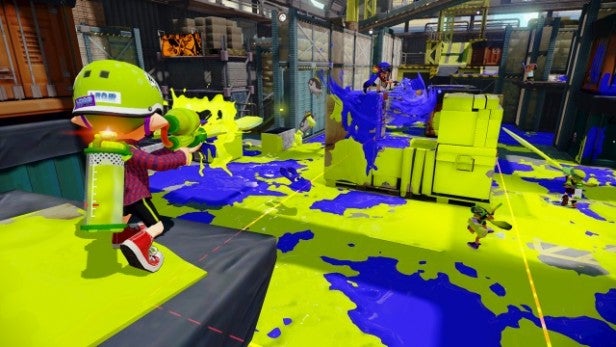
The best way to learn your moves is through the single-player campaign; a more accomplished effort than you might suspect. It puts you in the service of the crazed Captain Cuttlefish as he prepares to defend Inkopolis against the evil plans of the sinister Octopodes. While the story is paper-thin, the campaign goes much further than a series of lazy AI skirmishes. In fact, it’s closer to a platform-shooter than a shooter, pushing you to reach and rescue a captive zapfish by navigating a series of floating platforms and mechanisms, dispatching any Octopodes that stand in your way.
Like all of Nintendo’s best games, the campaign constantly drip-feeds in new enemies, obstacles and mechanics, giving you a chance to get used to each one before rolling them into more challenging configurations. Moving and rotating platforms, expanding and contracting ink sponges, invisible walkways, inky rails and patrolling squirters all need to be mastered, along with some big, brilliant end-of-area bosses. The worlds might lack the theming and magic of a Super Mario 3D Land, but there’s no lack of invention here. In fact, it’s a shame that more of the campaign’s ingenious mechanisms didn’t make it over to the multiplayer game’s maps.
See also: Star Wars Battlefront news and rumours
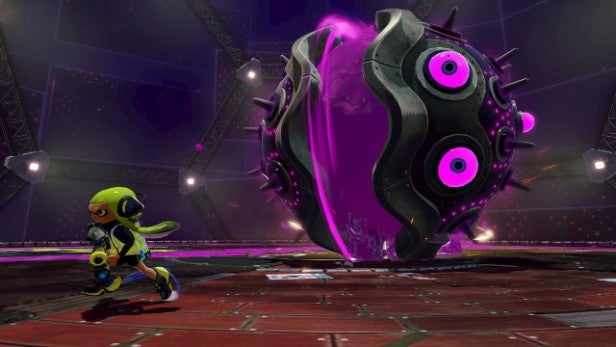
There’s nothing wrong with these; they’re well-designed and full of open spaces, high ground, tight choke points and sneaky routes. From skate parks to oil rigs to shopping malls and industrial zones, they’re perfect for showcasing your ink-swimming, wall-crawling, jumping skills. However, there’s not all that much to differentiate one from another bar some rather basic theming. And with only two in rotation for each of the main Battle and Ranked Battle modes on any day, repetition can wear thin over longer sessions.
In fact, in its early stages Splatoon can be something I never expected – a bit of a grind. You see, in the main Battle mode you’re stuck with one mode – the basic Turf War – and the Ranked Battle mode, with additional game modes, doesn’t kick in until you hit level 10. In the pre-release phase, we’ve also found that you’ll be matched with players of a much higher level, with better gear, better perks and more experience.
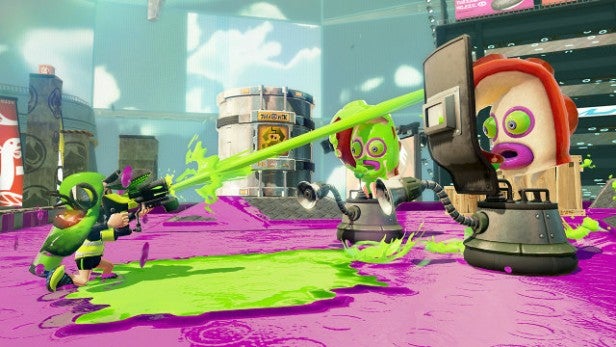
This isn’t a problem if you end up on a winning team, where the bonus for winning will see you shoot up levels fairly quickly, but you can end up with novice players struggling against a tough squad, and here the experience points all but crawl through. If that’s the case, you’ve only got one choice: keep playing, do the best you can and buy more gear and weapons as soon as you’re able. Here, playing the single-player campaign as help, not only making you more fluent in the game’s systems and controls, but unlocking blueprints for new weapons that you can then buy in the weapon store.
Ranked Battle mode promises more, with one additional game mode – a domination-style variant called Splat Zone – available at launch and additional modes to be released in the weeks after. Meanwhile, new Splatoon Amiibos are set to unlock additional challenge levels, though without one of the toys at the time of writing we’ve yet to give these a try.

The lack of variety still worries us, but here’s the thing: we never expected to be making comparisons between Splatoon and Destiny, but the two have something in common in that the desire for better kit, polished game mechanics and brilliant second-to-second gameplay help make up for a lack of variety. Splatoon might not have all the maps, events and modes of Destiny, but it still shines through because it’s so bright, colourful, vibrant and – most of all – fun.
It’s a pretty gorgeous game as well. At this stage, Nintendo seems to have mastered the Wii U’s hardware, working around its limitations through the use of colour, good art design and the kind of lighting you’d expect from a Pixar movie. It might not have the scale or detail of a GTA 5 or Witcher 3, but in its own way it’s beautiful, and the ink and fluid effects are plain out of whis world. Honestly, you feel like you can reach out and touch the glorious gloop. What’s more, the use of music, sound and visual cues is stellar, with a score that’s as bright and vibrant as the visuals.
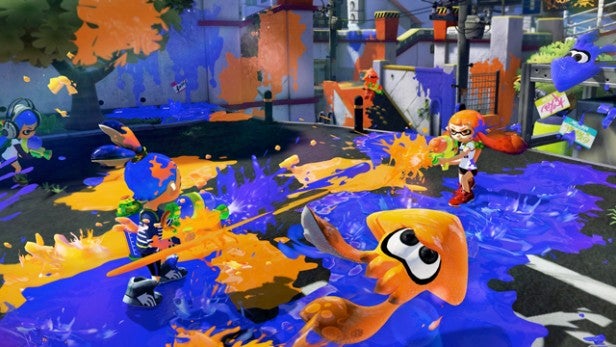
Right now, Splatoon feels like an exceptional work in progress: a brilliant first-step for a new franchise that needs more content before it’s fully-formed. That means that much rests on how the game progresses from here. During the review phase, we’ve been playing in less-than-ideal conditions with sparsely populated servers, waiting for enough players to join so that a match can begin. This has given us plenty of opportunity to play the fun, 8-bit style in-lobby minigame – an idea other games should swipe – but it has robbed the game of some of its flow, and we’ll be interested to see how the experience changes once the game launches proper.
Nintendo also promises to support Splatoon with new content during the summer, including the new maps and modes mentioned before, EA and Respawn’s long-term support have kept Titanfall alive over the last year, but we all know games where a lack of content and a greedy approach to DLC has resulted in a dwindling base of players. Nintendo needs to work hard to ensure that Splatoon stays as fresh and exciting as it feels at launch, and doesn’t suffer from the same cruel fate.
Verdict
There’s genuine Nintendo genius in the core mechanics, gameplay and vibrant visuals, with layers of depth and strategy both in the weapons and team tactics and in selecting and upgrading your gear. What’s more, Splatoon has a brilliant single-player mode with echoes of the Mario games. It’s biggest weakness is repetition, which Nintendo needs to fix with more maps and modes to come. Yet if Nintendo’s shooter isn’t perfect yet, it’s fantastically good fun right now.

